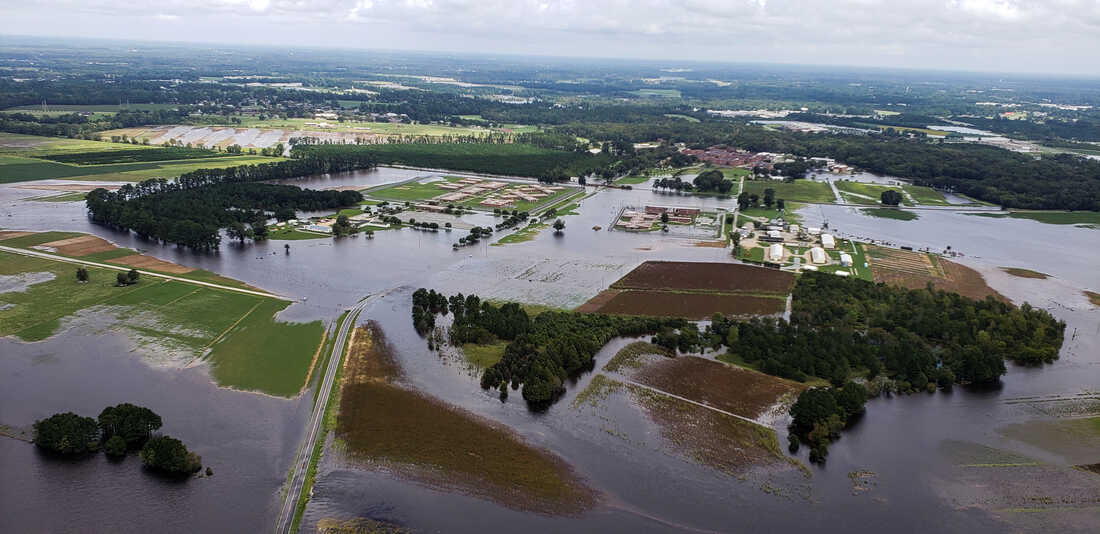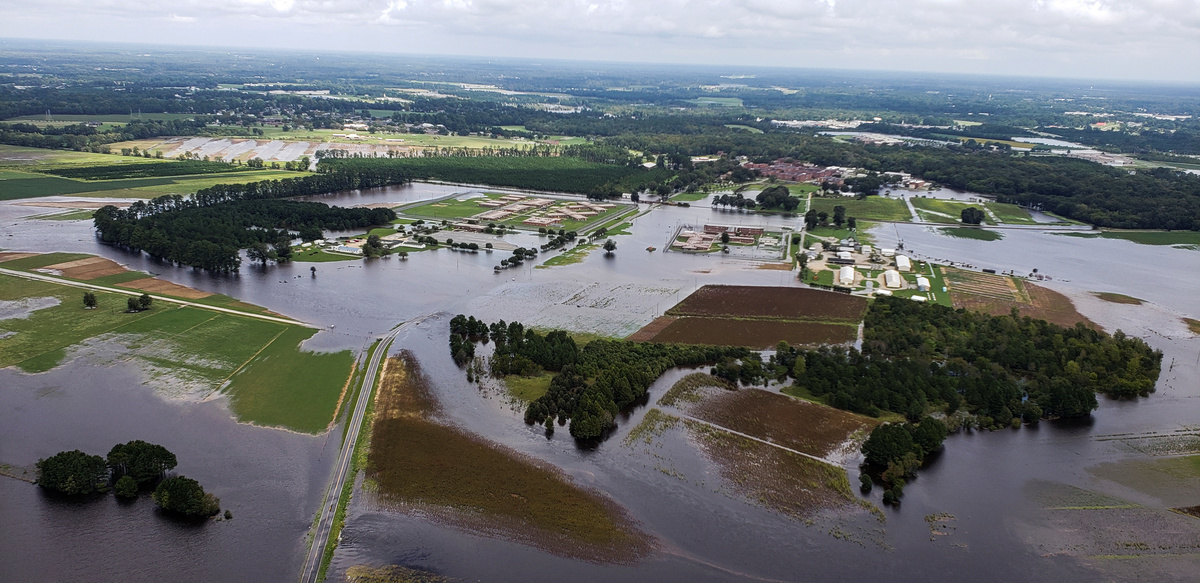Hog Waste Fears Raised Again as Dorian Approaches North Carolina

Pink ponds, like the one seen hither, are common on hog farms throughout Due north Carolina. The ponds, called hog lagoons, collect the animals' feces and are used for waste direction. Rodrigo Gutierrez/Reuters hibernate caption
toggle caption
Rodrigo Gutierrez/Reuters

Pink ponds, like the 1 seen here, are common on hog farms throughout North Carolina. The ponds, chosen hog lagoons, collect the animals' feces and are used for waste management.
Rodrigo Gutierrez/Reuters
With the full extent of the impairment done by Hurricane Florence still being assessed, environmentalists and wellness officials are expressing concern over the pink shaded ponds on squealer farms that have overflowed into surrounding flood waters.
No, those ponds aren't hogwash, they're actually pig waste material.
Technically, the pools of waste are hog lagoons. They're used to collect waste from the animals that then mixes with water in order to break the carrion downward.
Mark Rice, managing director of the animal and poultry waste management center at North Carolina State University, says the pink hue of a hog lagoon is the result of a bacteria in the mixture.
"It'southward actually a naturally occurring bacteria that consumes sulfur compounds," Rice told Weekend Edition host Scott Simon. "It's beneficial to have it in the lagoon. It helps reduce olfactory property to some extent, then if yous see that, you've got a healthy, operation lagoon."
And at that place are a lot of those lagoons in N Carolina, a country where the pork industry brings in billions of dollars. The country has said that at to the lowest degree 50 lagoons overflowed in the wake of Hurricane Florence and many more have the potential to spill over besides.

Hurricane Florence brought large amounts of pelting to Due north Carolina, resulting in widespread flooding. Flooding, particularly of grunter lagoons, has sparked environmental business organization in some areas. Rodrigo Gutierrez/Reuters hibernate explanation
toggle caption
Rodrigo Gutierrez/Reuters

Hurricane Florence brought large amounts of pelting to N Carolina, resulting in widespread flooding. Flooding, peculiarly of pig lagoons, has sparked environmental concern in some areas.
Rodrigo Gutierrez/Reuters
This has some people, including Kemp Burdette with the advocacy group Cape Fear River Watch, concerned nigh the ecology impact this overflow will cause.
"The water is not safe at all. I would expect to see extremely high levels of unsafe bacteria," Burdette said in an interview with Morning Edition host Steve Inskeep. "I as well know that this water is coming into contact with communities that are flooded and that's going to be a existent problem equally things evolve."
It's a problem that Northward Carolina has seen before.
In 1999, flooding from Hurricane Floyd caused lagoons to overflow and mix with inundation waters. At that time, large pork and poultry operations were loosely regulated, according to The New York Times.
Hurricane Floyd forced North Carolina to make changes. As NPR'south Dan Charles reports, that included the state'south decision to purchase out some of the farmers operating in flood plains and shut them downwardly, though some remain.
Rice says that overflows became less common after Hurricane Floyd, subsequently which farmers were forced to reevaluate how they conduct lagoon direction.
"It's uncommon simply considering the producers typically manage the lagoons to have their lagoons pumped down to the everyman possible level by hurricane season, and then past belatedly August," Rice says. "It's certainly something we don't want to see, but when you get 30 inches of rainfall in that location's going to exist some of that."
During a tour of the areas affected by the storm, Burdette was able to meet some of that damage firsthand.
"I saw numerous swine lagoons that had been completely inundated and overtopped by flood waters," he says. "I saw two lagoons that had failed altogether and emptied their contents entirely into flood waters."
For the ii lagoons that failed completely, Burdette says it's estimated that 7 million gallons of untreated swine feces were unleashed into surrounding waterways. As that waste overflows, Rice says it will ultimately become function of the surrounding ecosystem.
"What actually overflows is more dilute than what it would take been without the rain, and then with everything else that'south coming down the river it will go assimilated into the ecosystem ane way or another," Rice says. "In a instance similar this where there's the major flooding, virtually of the nutrients are going to become carried on out to the ocean."
Until the h2o is fully sampled and tested, Burdette says residents should be mindful of contact with the contaminated h2o and know the risks.
"As people are wading around in this water, and splashing this water up onto their confront, and this water is getting into their cuts and scrapes, it'southward going to be very unsafe," Burdette says. "At that place'due south going to be a lot of opportunities for people to go sick."
On Monday, the Ecology Protection Bureau put out a statement that several community systems in the state had stopped supplying drinking water and that the agency was monitoring for potential contamination. And on Fri, state officials in North Carolina said they were monitoring hog lagoons and working with water treatment plants and water systems "and responding to any releases or issues that touch on public water supply."
In an interview with Scientific discipline, microbiologist Rachel Noble said that while "municipal systems have regular testing protocol," it will even so take time to get results for larger systems also every bit the approximately 900,000 households that get their drinking water from private wells.
"To exist prophylactic, people should stick to bottled drinking water until their well can exist tested," Noble told Science.
Noble added that if people do ingest some contaminated h2o they might feel diarrhea, vomiting, and nausea.
The North Carolina Department of Agronomics and Consumer Services released a argument on Fri saying that farmers whose crops were flooded from the tempest would not be able to utilise those for homo consumption because of potential wellness risks.
"Crops and commodities exposed to floodwaters are considered adulterated by the U.S. Food and Drug Administration and cannot enter human food channels," the statement read. "They also cannot be used for animal feed unless they pass a testing protocol."
In addition to the loss of crops that farmers are facing, the land agronomics department estimates that 5,500 pigs died during the storm and 3.4 million birds were killed.
"It's a small fraction of what could accept been if there hadn't been steps taken to movement animals from flood prone areas from earlier the storm," Rice says. "Certainly it'south tragic but agriculture is a leaky system. Information technology's prone to all sorts of weather related perils and that's simply unfortunately the style it is."
Source: https://www.npr.org/2018/09/22/650698240/hurricane-s-aftermath-floods-hog-lagoons-in-north-carolina
Post a Comment for "Hog Waste Fears Raised Again as Dorian Approaches North Carolina"